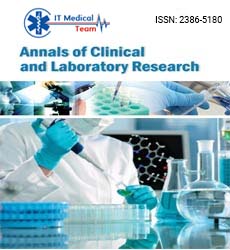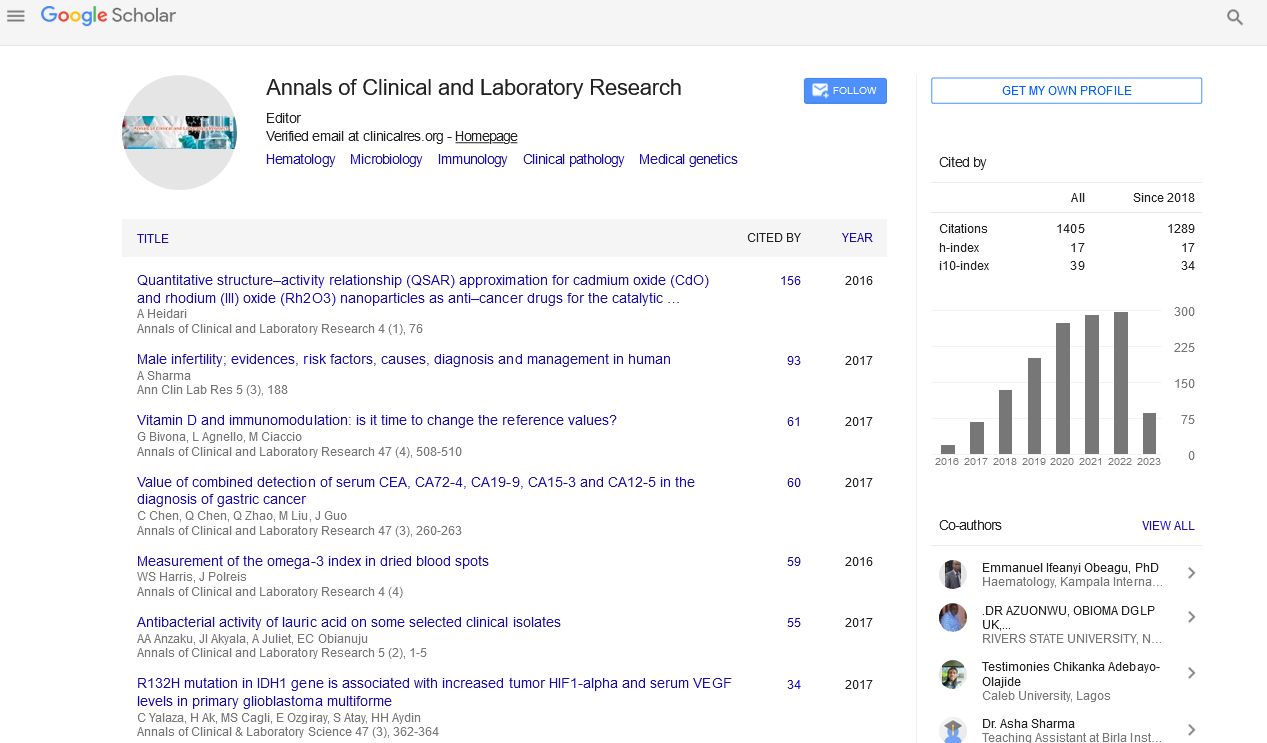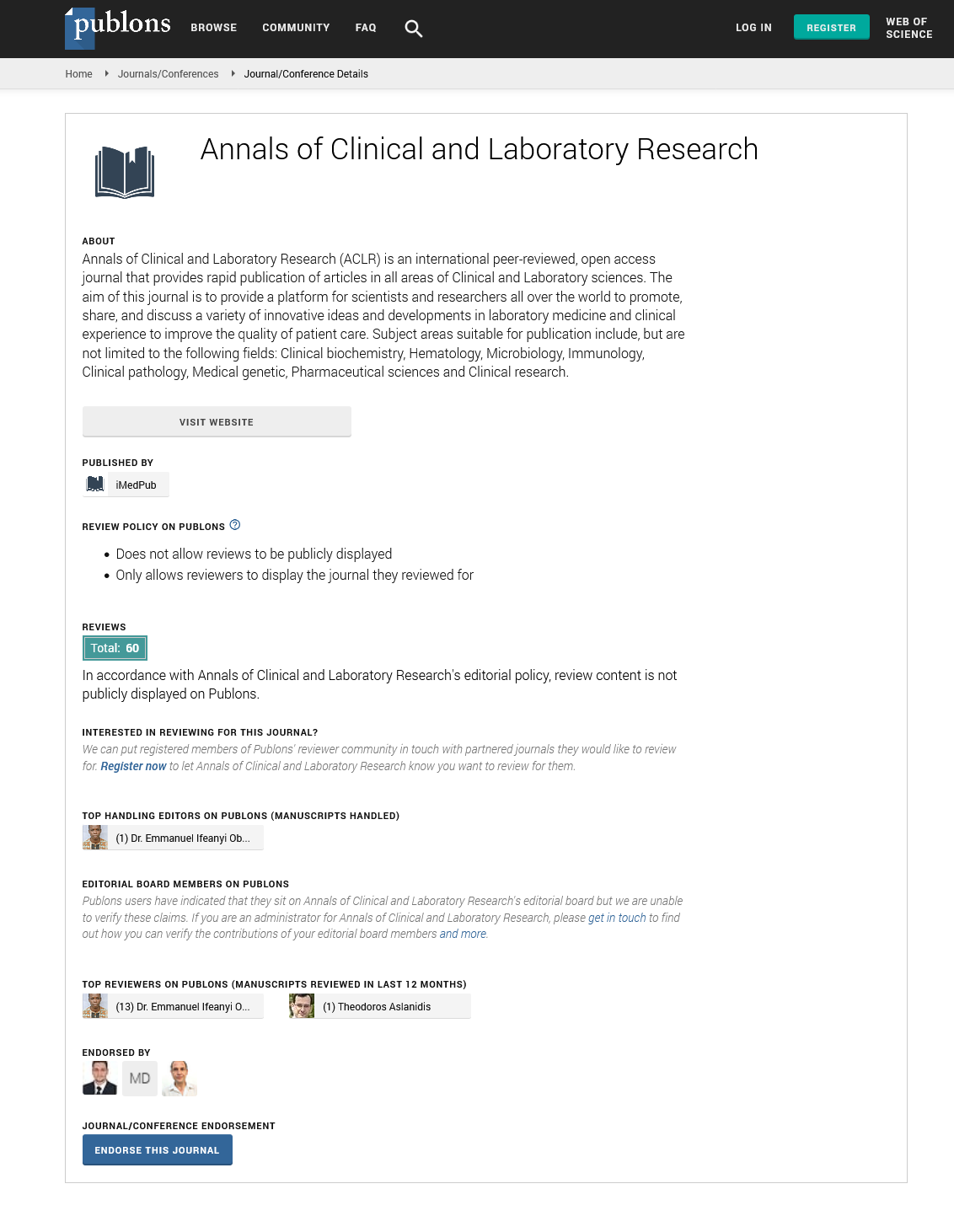Perspective - (2023) Volume 11, Issue 3
The impact of drug metabolism on drug design and optimization of prodrugs to metabolite targeting
Rosie Janina*
Department of Human Medicine, University of Applied Sciences and Medicine, Hamburg, Germany
*Correspondence:
Rosie Janina, Department of Human Medicine, University of Applied Sciences and Medicine,
Germany,
Email:
, Manuscript No. 13782;
, Pre QC No. 13782;
, QC No. 13782;
, Manuscript No. 13782;
Published:
31-May-2023, DOI: 10.36648/2386-5180.23.11.468
Abstract
Drug metabolism plays a significant role in drug design and optimization, shaping the pharmacokinetic and pharmacodynamics properties of pharmaceutical compounds. Understanding the metabolic fate of drugs in the body is crucial for enhancing their efficacy, improving safety profiles and maximizing therapeutic outcomes. This article explores the profound impact of drug metabolism on drug design and optimization, highlighting the utilization of prodrugs and metabolite targeting strategies to enhance drug performance
Keywords
Drug metabolism, Pharmacokinetic, Pharmacodynamics,
Biotransformation, Drug solubility, Stability, Bioavailability.
Introduction
Prodrugs are biologically inactive compounds that undergo
enzymatic biotransformation into active drug forms after
administration. This strategy takes advantage of specific metabolic
pathways to enhance drug delivery and optimize therapeutic
outcomes. By modifying the chemical structure of a drug,
prodrugs can improve drug solubility, stability and bioavailability.
Prodrugs design involves attaching a functional group to the
parent drug, rendering it inactive or less active until it undergoes
enzymatic conversion. This approach enables targeted drug
release at the site of action, prolongs drug circulation time and
reduces potential side effects. Prodrugs have been successfully
developed for a wide range of therapeutic areas, including pain
management, cancer treatment and antiviral therapies [1].
Active metabolites, generated through drug metabolism, can
exhibit enhanced pharmacological activity compared to the
parent drug. Metabolite targeting involves designing drugs that
are specifically metabolized into active metabolites, which are
responsible for the desired therapeutic effects. This approach
allows for a more precise and selective action of the drug,
potentially reducing off-target effects and improving therapeutic
efficacy. Metabolite targeting requires a comprehensive
understanding of the metabolic pathways involved and the
identification of the specific enzymes responsible for metabolite
formation. By optimizing drug structures and designing prodrugs
that selectively generate active metabolites, researchers can improve drug potency, prolong the duration of action and
enhance therapeutic response [2].
Individuals exhibit interindividual variability in drug metabolism
due to genetic differences in drug-metabolizing enzymes.
Pharmacogenetics, the study of how genetic variations influence
drug response, plays a crucial role in tailoring drug therapy
based on metabolic variability. By identifying specific genetic
variants associated with altered drug metabolism, clinicians can
personalize treatment approaches, optimizing drug selection
and dosing regimens. Pharmacogenetic testing enables the
identification of individuals who may be poor or ultra-rapid
metabolizers of certain drugs. This information helps guide
dosage adjustments, prevent adverse drug reactions and improve
treatment outcomes. Incorporating pharmacogenetic data into
drug design and optimization can lead to the development of
tailored therapies that account for individual variations in drug
metabolism [3].
Metabolic Pathways: Understanding the metabolic pathways
of a drug is essential for prodrugs design. Different metabolic
pathways can lead to the formation of various metabolites,
some of which may have desirable pharmacological properties.
By designing prodrugs that preferentially undergo specific
metabolic pathways, researchers can optimize the formation of
desired metabolites.
Enzymatic Conversion: Drug metabolism often involves the action
of enzymes, such as cytochrome P450 enzymes, which catalyse the biotransformation of drugs. Prodrugs can be designed to be
selectively activated by specific enzymes to generate metabolites
with enhanced therapeutic activity or improved pharmacokinetic
properties. For example, prodrugs can be engineered to be
selectively metabolized by an enzyme overexpressed in a target
tissue, leading to localized drug activation and increased efficacy
[4].
Metabolite Targeting: Prodrugs can be designed to target
specific metabolites that exhibit improved drug-like properties.
By identifying metabolites with desirable pharmacological
characteristics, such as increased potency, selectivity, or
reduced toxicity, prodrugs can be optimized to enhance
therapeutic outcomes. Additionally, targeting metabolites with
longer half-lives can extend drug action and reduce dosing
frequency. Continued research in drug metabolism holds
immense potential for advancing drug design and optimization.
Utilizing computational approaches, such as in silicon modelling
and simulation, can aid in predicting and optimizing drug
metabolism, enabling the development of more efficient and
effective therapeutic agents. Integration of pharmacokinetic
and pharmacodynamics data, along with metabolic pathway
analysis, can provide valuable insights into the design of
prodrugs and targeted therapies. Furthermore, the advancement
of technologies, such as micro dosing and micro sampling
techniques, allows for early evaluation of drug metabolism in
clinical trials, facilitating informed decision-making during drug
development [5].
Conclusion
Drug metabolism plays a crucial role in drug design and optimization, offering opportunities to enhance drug delivery
improve therapeutic efficacy and minimize adverse effects.
Prodrugs and metabolite targeting strategies leverage the
intricate pathways of drug metabolism to optimize drug
performance. Incorporating pharmacogenetic information
enables personalized drug therapy based on individual
metabolic variability. The utilization of computational tools and
advanced technologies further advances our understanding of
drug metabolism, allowing for more efficient drug design and
optimization.
References
- Kumar G, Bhatt M (2023). Formulation and Optimization of Trandolapril Oro-dispersible Tablets using the Quality by Design (QbD) Approach. Lett Drug Des Discov.20(9):1194-203.
Indexed at, Google Scholar, Cross Ref
- Manevski N, King L, Pitt WR, Lecomte F, Toselli F (2019). Metabolism by aldehyde oxidase: drug design and complementary approaches to challenges in drug discovery. J Med Chem.62(24):10955-94.
Indexed at, Google Scholar, Cross Ref
- Segall M (2014). Advances in multiparameter optimization methods for de novo drug design. Expert Opin Drug Discov.9(7):803-17.
Indexed at, Google Scholar, Cross Ref
- Wernevik J, Bergstrom F, Noven A, Hulthe J, Fredlund L, et al (2020). A fully integrated assay panel for early drug metabolism and pharmacokinetics profiling. Assay Drug Dev Technol.18(4):157-79.
Indexed at, Google Scholar, Cross Ref
- Yang H, Sun L, Wang Z, Li W, Liu G, et al (2018). ADMETopt: a web server for ADMET optimization in drug design via scaffold hopping. J Chem Inform Mod. 58(10):2051-6.
Indexed at, Google Scholar, Cross Ref
Citation: Janina R (2023) The impact of drug metabolism on drug design and optimization of prodrugs to metabolite targeting. Ann Clin Lab Res. Vol.11 No.3:468






